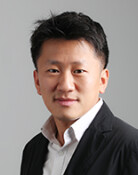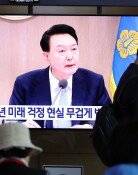President Moon Jae-in’s visit to Samsung Electronics
President Moon Jae-in’s visit to Samsung Electronics
Posted May. 01, 2019 07:57,
Updated May. 01, 2019 07:57
South Korean President Moon Jae-in made his first visit on Tuesday to Samsung Electronics’ Hwaseong Campus that produces semiconductors. He announced a vision to make Korea to grow as the top country in the semiconductor sector by becoming the world’s best in the foundry industry and achieving a market share of 10 percent in the fabless market by 2030. The presidential announcement made during a visit to a leading Korean company can boost investment sentiment among businesses amid economic difficulties at home and abroad.
The South Korean government has promised to invest 1 trillion won in research and development with the goal of solidifying the nation’s industrial basis for system semiconductors, which has a weaker competitiveness edge over compared to memory semiconductors. It is also committed to creating pubic demand for design-specific semiconductor firms and establishing a semiconductor department at Korean University and Yonsei University to nurture talent. The belated but meaningful progress in the third year of Moon’s presidential term it has a long way to go. The government should lay out various incentives to boost its eight new core industries – EVs, robotics, bio-health, aerospace, energy, new material, display and semiconductors.
Since the Park Chung-hee administration, South Korea had pushed forward with strong industrial support policies to replace imports with domestic products and boost heavy chemical industries, which eventually led the Miracle of Han River. However, the government has focused less on industrial growth incentives since the 1997 Asian financial crisis gave birth to neo-liberalism, which is characterized by a greater role of the market and minimum government regulation. Just as the Internet derived from the U.S. government-led development of military-purpose communication networks, a nation’s industrial competitiveness edge is inevitably related to government-led research and public procurement.
The world is recently witnessing the rise of neo-mercantilism. Even the United States, known as a key player in the free market economy, has explicitly sparked trade conflicts with Europe, China and Japan to safeguard its domestic industries and technologies. China is beefing up its efforts to grow industries and exceed Germany and Japan by setting “Manufacturing 2025.” The government’s leadership matters to a country just as small as Korea being sandwiched between economic powerhouses when it comes to core industry development and economic advancement.
Amid a growing trend of winners taking it all and job markets facing fast shifts, the government must nurture creative minds and innovate technologies in the era of the 4th industrial revolution. In the meanwhile, it is important for the government and society to open up new industrial opportunities and help the socially disadvantaged stand back on their feet. The government should offer policies that widen ways to future cutting-edge industries and boost related social support.
Headline News
- Israel prepares for retaliation against Iran
- Samsung reclaims top spot, surpassing Apple in smartphone market
- 77% of Koreans in 20s and 30s are 'Kangaroo Tribe' due to job crisis
- KBO referees embroiled in controversy over ABS decision concealment
- Inflation, oil price surge put double shock on global economy






